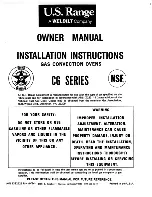
13
About changing the power level.
GEAppliances.com
The power level may be entered or changed
immediately after entering the time for
Time
Cook, Time Defrost
or
Express Cook.
The
power level may also be changed during time
countdown.
1
First, follow directions for
Time Cook, Time
Defrost
or
Express Cook
.
2
Press the
POWER
button.
3
Turn the dial clockwise to increase and
counterclockwise to decrease the power
level. Press the dial to enter.
4
Press the
START/PAUSE
button to start
cooking.
Variable power levels add flexibility to
microwave cooking. The power levels on the
microwave oven can be compared to the
surface units on a range. Each power level gives
you microwave energy a certain percent of the
time.
Power level 7
is microwave energy 70%
of the time.
Power level 3
is energy 30% of the
time. Most cooking will be done on
High (power
level 10)
which gives you 100% power.
Power
level 10
will cook faster but food may need
more frequent stirring, rotating or turning over.
A lower setting will cook more evenly and need
less stirring or rotating of the food. Some foods
may have better flavor, texture or appearance
if one of the lower settings is used. Use a lower
power level when cooking foods that have
a tendency to boil over, such as scalloped
potatoes.
Rest periods (when the microwave energy
cycles off) give time for the food to “equalize”
or transfer heat to the inside of the food. An
example of this is shown with
power level 3
³
the defrost cycle. If microwave energy did not
cycle off, the outside of the food would cook
before the inside was defrosted.
Here are some examples of uses for various
power levels:
High 10:
Fish, bacon, vegetables, heating
liquids.
Med-High 7:
Gentle cooking of meat and
poultry; baking casseroles and reheating.
Medium 5:
Slow cooking and tenderizing for
stews and less tender cuts of meat.
Low 2 or 3:
Defrosting; simmering; delicate
sauces.
Warm 1:
Keeping food warm; softening butter.
Microwave terms.
Arcing
Arcing is the microwave term for sparks in the oven. Arcing is caused by:
the metal shelf being installed incorrectly and touching the microwave walls.
metal or foil touching the side of the oven.
foil that is not molded to food (upturned edges act like antennas).
metal such as twist-ties, poultry pins, gold-rimmed dishes.
recycled paper towels containing small metal pieces.
the turntable ring support being installed incorrectly.
Covering
Covers hold in moisture, allow for more even heating and reduce cooking time. Venting plastic wrap or
covering with wax paper allows excess steam to escape.
Shielding
In a regular oven, you shield chicken breasts or baked foods to prevent over-browning. When microwaving,
you use small strips of foil to shield thin parts, such as the tips of wings and legs on poultry, which would
cook before larger parts.
Standing Time
When you cook with regular ovens, foods such as roasts or cakes are allowed to stand to finish cooking or
to set. Standing time is especially important in microwave cooking. Note that a microwaved cake is not
placed on a cooling rack.
Venting
After covering a dish with plastic wrap, you vent the plastic wrap by turning back one corner so excess
steam can escape.
Term
Definition
Содержание CVM1750
Страница 7: ...7 Notes GEAppliances com ...
Страница 25: ...25 Notes GEAppliances com ...
Страница 26: ...26 Notes ...
Страница 39: ...11 Notes GEAppliances com ...
Страница 61: ...33 Notas GEAppliances com ...
Страница 62: ...34 Notas ...














































